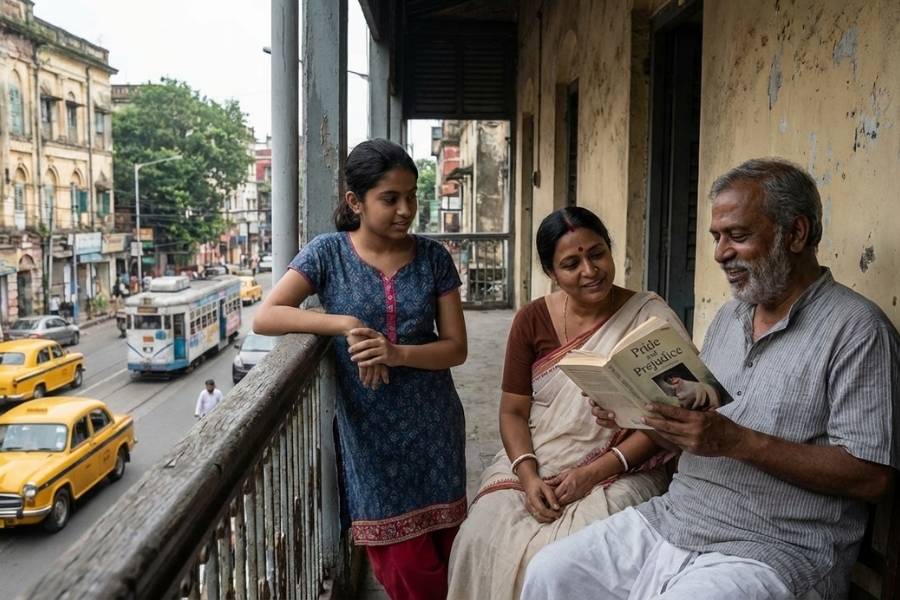India’s once-soaring stock market just hit an unwelcome milestone – a record-breaking 10-day losing streak for its blue-chip NSE Nifty 50 Index as foreign investors continue to pull out in droves.
The Nifty 50 Index dipped another 0.17 per cent, or 36.65 points, to close at 22,082.65, extending its fall from September’s high to a 16 per cent decline. Tuesday’s fall marked the Nifty 50's longest losing streak since the index was launched in 1996. It peaked last September 26 at 26,2116.05.
Analysts say the bleeding is not over yet.
Global funds have yanked nearly $14 billion from Indian equities this year, unnerved by slowing economic growth and the market’s still-lofty valuations. The BSE index finished at 72,989.93, declining by 96.01 points.
“Escalating global trade tensions” due to the tariff war unleashed by President Donald Trump are weighing on markets, says Vinod Nair, research head at Geojit Financial Services.
From its record peak of 85,978.25 on September 27 last year, the BSE benchmark index is down over 13,000 points, or 15.15 per cent, as of Tuesday’s session.
The NSE Nifty 50 Index has shed 4 per cent in 10 days, totaling a 7 per cent drop in 2025 so far. Meanwhile, midcap and smallcap stocks have taken an even bigger hit, with the Nifty Midcap Index down 16 per cent and the Nifty Smallcap Index trading 21 per cent lower.
And more selling is in store. Samir Arora, chief investment officer of Helios Capital, says it could take one or two months for domestic benchmarks to bottom out. “Repair of investor confidence might take another three to four months. Healing or recovery will take six to nine months,” Arora told India Today.
The relentless sell-off has wiped out over $1 trillion in market capitalisation since the start of the year, dragging India’s share of the global equity market below 3 per cent — a level not seen in two years. India’s global equity market share has tumbled to 2.9 per cent from nearly 4 per cent at the start of 2025.
“Concerns over continued FII selling, the imposition of tariffs by the US on Canada, Mexico, and China, and ongoing geopolitical tensions between Russia and Ukraine continue to impact domestic market sentiments,” says Siddhartha Khemka, head of research, wealth management, at Motilal Oswal Financial Services.
Helping grease the Indian market slide – the deepest rout in decades – are disappointing economic growth numbers that have fallen short of expectations, says Nilesh Shah, managing director at Kotak Mahindra Asset Management. Also, company earnings have failed to justify high valuations, prompting investors to rethink their positions, he told CNBC-TV18.
Markets elsewhere gain
While Indian equities are in freefall, markets elsewhere have been gaining. The UK’s FTSE 100 has surged 10 per cent, and France’s CAC 40 is up 12 per cent this year, making India’s nearly 9 per cent slump in dollar terms stand out as the steepest decline among major global markets.
The total market cap of listed Indian companies has shrunk by 23.3 per cent, now standing at $3.8 trillion. For perspective, India has averaged around 2.8 per cent of the global equity market over the past decade.
It’s a striking shift from just a few months ago when India was the golden child of emerging-market investors. But the tides have turned fast. A rebound in Chinese stocks, a stronger dollar, and persistent foreign outflows have dented India’s appeal.
The Nifty 50 had been riding high, surging 16 per cent post-May elections, only to see those gains wiped out. For India’s young, first-time investors — who have flooded the market in recent years — this downturn is a wake-up call. An estimated two out of three Indian investors have never faced a true bear market. If the slump drags on, domestic money could dry up, further pressuring the market.
Analysts say the wealth erosion this time is deeper and wider than in previous stock market crashes due to the sharp growth of India’s retail share market as new investors have piled in.
Despite the slump, Indian stocks remain relatively expensive. India’s stock market trades at a premium to other emerging markets, with weak corporate earnings and sluggish profit forecasts making investors wary. The Nifty 50 trades at 18.1 times its one-year forward earnings, compared to South Korea’s Kospi (8.8x), Taiwan’s TAIEX (15.6x), and China’s Shanghai Composite (12x).
There could be some glimmers of hope with the government’s push to boost consumption and ongoing trade talks with the US to avoid new tariffs. Citigroup recently upgraded Indian stocks, calling valuations more reasonable, while JP Morgan Asset Management sees potential in Indian banks and real estate investment trusts.
Shah believes the market correction has paved the way for long-term investors to selectively accumulate “quality” stocks. But he warns the immediate outlook remains uncertain. "If foreign portfolio investors continue their aggressive selling, buyers will step in at progressively lower prices. As long as this selling persists, the markets are unlikely to stabilise."
He warns, though, against reckless investing in a volatile market: "Never stand in front of a running train. This is an opportunity to accumulate gradually, not to go all in at once."
Shah highlighted some signs to watch for in looking for a recovery. "When foreign portfolio investors stop their aggressive selling and turn net buyers, it could signal that valuations have become attractive again." Also, he told CNBC, "Right now, the global landscape is in a lose-lose scenario, with the US imposing tariffs and multiple markets suffering. If these geopolitical tensions ease, markets could find a bottom."












